Manos de poker
En PokerStars ofrecemos muchas variedades de poker, algunas de las cuales utilizan clasificaciones de manos diferentes. En Hold'em, Omaha, Seven Card Stud y Five Card Draw se utiliza la clasificación tradicional de manos altas. Por el contrario, en Omaha Hi/Lo, Razz y Stud Hi/Lo se recurre al sistema de clasificación para manos bajas "Ace to Five" ("California"). En 2-7 Single Draw y 2-7 Triple Draw se utiliza la clasificación para manos bajas "Deuce to Seven" ("Kansas City") para el poker a la baja (lowball).
Manos de poker, de la mejor a la peor
Clasificación tradicional de manos altas en poker
Escalera de color: cinco cartas consecutivas del mismo palo.
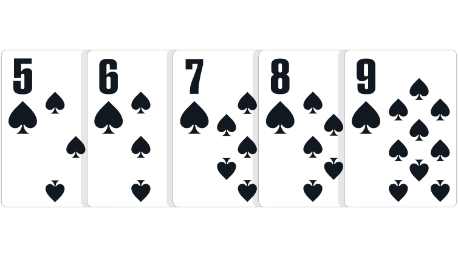
Si hay un empate: la escalera más alta gana.
La escalera de color más alta que se puede conseguir se denomina escalera real, y consiste en un as, rey, dama, jota y diez del mismo palo. Una escalera real es una mano imbatible.
Poker: Cuatro cartas del mismo valor y una carta desemparejada o kicker.
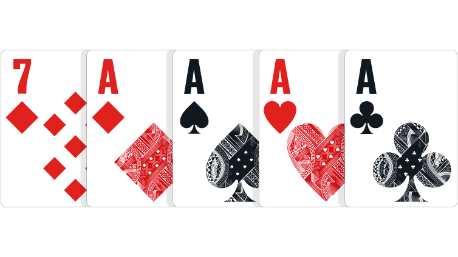
Si hay un empate: el poker mayor gana. En juegos de cartas comunitarias donde los jugadores tienen el mismo poker, gana la quinta carta diferente más alta o kicker.
Full: Tres cartas del mismo valor y otras dos cartas del mismo valor, diferente al anterior.
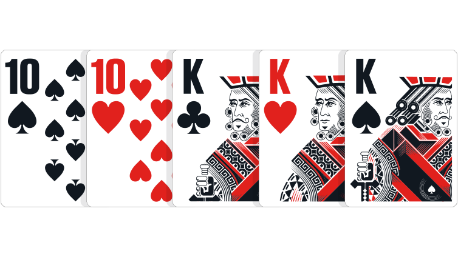
Si hay un empate: las tres cartas del mismo valor más altas ganan el bote. En juegos de cartas comunitarias donde los jugadores tienen las mismas tres cartas iguales, gana la mano con las dos cartas de un valor distinto más altas.
Color: cinco cartas del mismo palo.
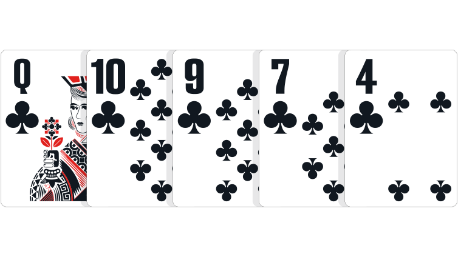
Si hay un empate: el jugador con la carta más alta gana. Si es necesario, la segunda, tercera, cuarta y quinta carta más alta pueden romper el empate. Si las cinco cartas tienen el mismo valor el bote se repartirá. En el juego de poker el palo de las cartas nunca se utiliza para deshacer un empate.
Escalera: cinco cartas de valores consecutivos.

Si hay un empate: la escalera con la carta más alta gana.
Nota: el as es la única carta que se puede usar en la parte alta o baja de la secuencia. La combinación A-K-Q-J-10 ("Ace high" o "al as") es la escalera más alta mientras 5-4-3-2-A ("Five high" o "al cinco") es la más baja.
Trío: tres cartas del mismo valor y dos cartas desemparejadas.
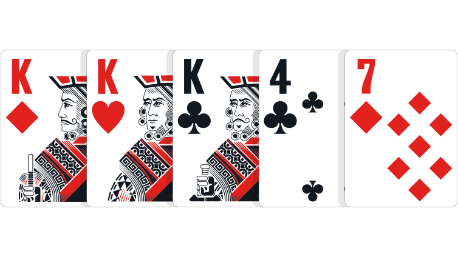
Si hay un empate: el trío de cartas de mayor valor gana. En los juegos con cartas comunitarias donde más de un jugador posee el mismo trío, gana la carta más alta no emparejada, y si fuera necesario, la segunda carta más alta no emparejada.
Doble pareja: dos cartas de un mismo valor, combinadas con otras dos cartas de un mismo valor (distinto al primero) y una quinta diferente.
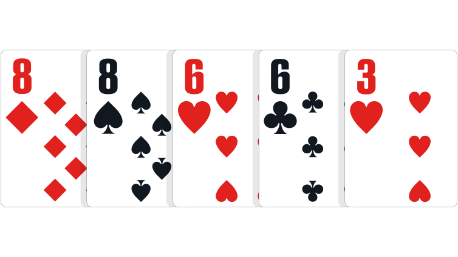
Si hay un empate: la pareja más alta gana. Si los jugadores tienen la misma pareja más alta, la segunda pareja más alta gana. Si ambos jugadores tienen parejas idénticas, gana la carta de valor diferente más alta.
Pareja: dos cartas del mismo valor y tres cartas desemparejadas.

Si hay un empate: la pareja más alta gana. Si los jugadores tienen la misma pareja, la carta diferente más alta gana y, si es necesario, la segunda y la tercera carta diferentes pueden utilizarse para romper el empate.
Carta alta: cualquier mano que no entre en ninguna de las categorías anteriores.
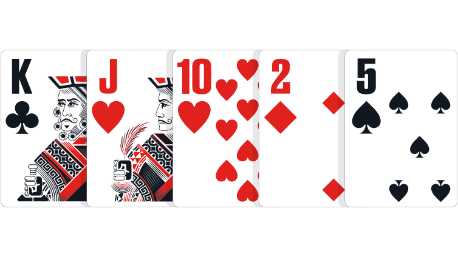
Si hay un empate: la carta más alta gana y, si es necesario, la segunda, tercera, cuarta y quinta carta diferentes pueden utilizarse para romper el empate.
Clasificación de manos "Ace to Five" para el poker a la baja (lowball)
Este método de clasificación de manos bajas se utiliza en los clásicos juegos Hi/Lo tales como el Omaha Hi/Lo y el Stud Hi/Lo así como, en el Razz, el Stud "low only".
Ten en cuenta que los palos carecen de importancia cuando se juega a la baja siguiendo el sistema "Ace to Five". Ni el color ni una escalera afectan a una mano de poker a la baja según el "Ace to Five". Los ases son siempre las cartas más pequeñas cuando se juega a la baja.
Recuerda además que el valor de una mano de cinco cartas a la baja comienza con la carta más alta y disminuye a partir de ahí.
Cinco baja o rueda: cinco, cuatro, tres, dos y as.
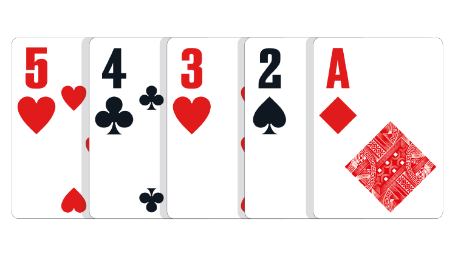
Si hay un empate: todas las manos con cinco alta se reparten el bote.
Seis baja: cinco cartas que no forman pareja y la carta más alta un seis.
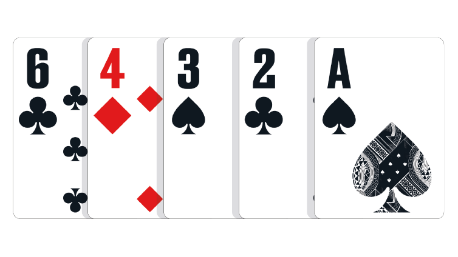
Si hay un empate: la segunda carta alta más baja gana el bote. Por lo tanto, 6, 4, 3, 2, A vence a 6, 5, 4, 2, A. Si es necesario, la tercera, cuarta o quinta cartas más altas pueden utilizarse para romper el empate.
Siete baja: cinco cartas que no forman pareja y la carta más alta es un siete.
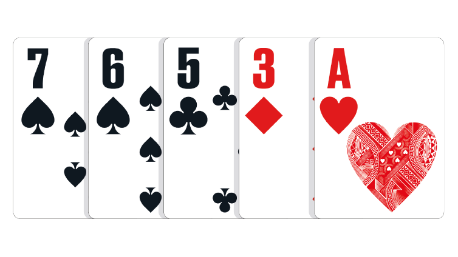
Si hay un empate: la segunda carta más alta carta más baja se lleva el bote. Si es necesario, la tercera, cuarta y quinta carta más alta de la mano pueden romper el empate.
Ocho baja: cinco cartas que no forman pareja y la carta más alta es un ocho.
Si hay un empate: la segunda carta más alta carta más baja se lleva el bote. Si es necesario, la tercera, cuarta y quinta carta más alta de la mano pueden romper el empate.
Una mano "ocho baja" es la mano más débil que se clasifica para la baja en las variantes Omaha Hi/Lo y Stud Hi/Lo. Sin embargo, en el Razz no existe tal "requisito" y la mano más baja ganará siempre el bote, incluso si se trata de un "nueve baja", "dama baja" o incluso una pareja.
Clasificación de manos "Deuce to Seven" para el poker a la baja (lowball)
El poker a la baja según el sistema de clasificación de manos "Deuce to Seven" es exactamente el opuesto a la tradicional clasificación de manos en los juegos High. Por ello, la que constituye la peor mano posible en el tradicional poker a la alta (el siete-cinco alta con palos diferentes) se convierte en la mejor mano posible en el Deuce to Seven lowbal (un "siete perfecto" baja o "rueda" (wheel)).
En la práctica, en el Deuce to Seven el as siempre juega el papel de una carta alta (así un A-5-4-3-2 es un as alto, y no una escalera). En Deuce to Seven las escaleras y los colores perjudican a tu mano.
Siete baja: todo conjunto de cinco cartas que no formen parejas ni combinaciones entre sí, de diferentes palos, con el siete como carta más alta. La mejor mano posible es un 7-5-4-3-2, también conocido como una "rueda".
Si hay un empate: la segunda carta más baja se lleva el bote. Así por ejemplo, un 7-5-4-3-2 superará a un 7-6-5-3-2 (un "siete-cinco" a la baja supera a un "siete-seis" a la baja). Si es necesario, la tercera, cuarta y quinta carta más alta de la mano pueden romper el empate.
Ocho baja: todo conjunto de cinco cartas que no formen parejas ni combinaciones entre sí, de diferentes palos, con el ocho como carta más alta.
Si hay un empate: la segunda carta más baja se lleva el bote. Si es necesario, la tercera, cuarta y quinta carta más alta de la mano pueden romper el empate.
Nueve baja: todo conjunto de cinco cartas que no formen parejas ni combinaciones entre sí, de diferentes palos, con el nueve como carta más alta.
Si hay un empate: la segunda carta más baja se lleva el bote. Si es necesario, la tercera, cuarta y quinta carta más alta de la mano pueden romper el empate.
Diez baja: todo conjunto de cinco cartas que no formen parejas ni combinaciones entre sí, con el diez como carta más alta.
Si hay un empate: la segunda carta más baja se lleva el bote. Si es necesario, la tercera, cuarta y quinta carta más alta de la mano pueden romper el empate.
Nota: no existe ningún requisito para optar a la mano baja en los juegos de "lowball" que utilizan la clasificación de manos "Deuce to Seven". Lo anterior son solo ejemplos de manos que pueden darse en el juego, ganando siempre el bote la mano más baja en el "Deuce to Seven", ¡aunque se trate de una pareja o de una combinación peor!
Cómo saber quién tiene la mejor mano en el poker
Cuando ya domines la clasificación de manos, puedes empezar a pensar en la mejor manera de jugar tu mano y en la probabilidad que tiene de vencer a otras manos.
En general, se aplican las siguientes reglas:
- Pareja > carta alta
- Doble pareja > pareja
- Trío > doble pareja
- Escalera > trío
- Color > escalera
- Full > color
- Poker > full
- Escalera de color > poker
- Escalera real > escalera de color
¿Cómo se calcula la probabilidad de una mano de poker?
Las barajas de poker tienen 52 cartas y 2.598.960 combinaciones de manos posibles. Para calcular la probabilidad de una mano, tienes que considerar el número de formas posibles de conseguirla.
Por ejemplo, hay cuatro formas de conseguir una escalera real, ya que hay cuatro palos. Así que el cálculo matemático para determinar la probabilidad de esta mano sería: 4 ÷ 2.598.960 = 0,00000154.
Información adicional
Escalera de color: cinco cartas consecutivas del mismo palo.

Si hay un empate: la escalera más alta gana. La escalera de color más alta que se puede conseguir se denomina escalera real y consiste en un as, rey, reina, jota y diez del mismo palo. Una escalera real es una mano imbatible.
Poker: cuatro cartas iguales y una diferente (kicker).

Si hay un empate: el poker mayor gana. En juegos de cartas comunitarias donde los jugadores tienen el mismo poker, gana la quinta carta diferente más alta o kicker.
Full house: tres cartas del mismo valor y dos cartas de un valor distinto, pero coincidentes entre ellas.

Si hay un empate: las tres cartas del mismo valor más altas ganan el bote. En juegos de cartas comunitarias donde los jugadores tienen las mismas tres cartas iguales, gana la mano con las dos cartas de un valor distinto más altas.
Color: cinco cartas del mismo palo.

Si hay un empate: el jugador con la carta más alta gana. Si es necesario, la segunda, tercera, cuarta y quinta carta más alta pueden romper el empate. Si las cinco cartas tienen el mismo valor el bote se repartirá. En el juego de poker el palo de las cartas nunca se utiliza para deshacer un empate.
Escalera: cinco cartas consecutivas.

Si hay un empate: la escalera más alta gana.
Nota: el as es la única carta que se puede usar en la parte alta o baja de la secuencia. La combinación A-K-Q-J-10 (Ace high) es la escalera más alta mientras 5-4-3-2-A (Five high) es la más baja.
Trío: tres cartas del mismo valor y dos de un valor diferente.

Si hay un empate: el trío más alto gana. En los juegos con cartas comunitarias donde más de un jugador posee el mismo trío, gana la carta más alta no emparejada, y si fuere necesario, la segunda carta más alta no emparejada.
Doble pareja: dos cartas del mismo valor, combinadas con otras dos cartas del mismo valor y una quinta diferente.

Si hay un empate: la pareja más alta gana. Si los jugadores tienen la misma pareja más alta, la segunda pareja más alta gana. Si ambos jugadores tienen parejas idénticas, gana la carta de valor diferente más alta.
Pareja: dos cartas del mismo valor y tres de valores diferentes.

Si hay un empate: la pareja más alta gana. Si los jugadores tienen la misma pareja, la carta diferente más alta gana y, si es necesario, la segunda y la tercera carta diferentes pueden utilizarse para romper el empate.
Carta alta: cualquier mano que no pertenece a ninguna de las categorías anteriores.

Si hay un empate: la carta más alta gana y, si es necesario, la segunda, tercera y cuarta carta diferentes pueden utilizarse para romper el empate.
Este método de clasificación de manos bajas se utiliza en los clásicos juegos Hi/Lo tales como el Omaha Hi/Lo y el Stud Hi/Lo así como, en el Razz, el Stud low only.
Ten en cuenta que los palos carecen de importancia cuando se juega a la baja siguiendo el sistema “Ace to Five”. Ni el color ni una escalera afectan a una mano de poker a la baja según el “Ace to Five”. Los ases son siempre las cartas más pequeñas cuando se juega a la baja.
Recuerda además que el valor de una mano de cinco cartas a la baja comienza con la carta más alta y disminuye a partir de ahí.
Cinco baja o rueda: Cinco, Cuatro, Tres, Dos y As.

Si hay un empate: todas las manos con cinco alta se reparten el bote.
Seis baja: cinco cartas que no forman pareja y la carta más alta un Seis.

Si hay un empate: la segunda carta alta más baja gana el bote. Por lo tanto, 6, 4, 3, 2, A vence a 6, 5, 4, 2, A. Si es necesario, la tercera, cuarta o quinta cartas más altas pueden utilizarse para romper el empate.
Siete baja: cinco cartas que no forman pareja y la carta más alta es un Siete.

Si hay un empate: la segunda carta alta más baja gana el bote. Si es necesario, la tercera, cuarta o quinta cartas más altas pueden utilizarse para romper el empate.
Ocho baja: cinco cartas que no forman pareja y la carta más alta es un Ocho.

Si hay un empate: la segunda carta alta más baja gana el bote. Si es necesario, la tercera, cuarta y quinta cartas más altas pueden utilizarse para romper el empate.
Una mano “ocho baja” es la mano más débil que se clasifica para la baja en las variantes Omaha Hi/Lo y Stud Hi/Lo. Sin embargo, en el Razz no existe tal “requisito” y la mano más baja ganará siempre el bote, incluso si se trata de un “nueve baja”, “reina baja” o incluso una pareja.
El poker a la baja según el sistema de clasificación de manos “Deuce to Seven” es exactamente el opuesto a la tradicional clasificación de manos en los juegos High. Por ello, la que constituye la peor mano posible en el tradicional poker a la alta (el siete-cinco alta con palos diferentes) se convierte en la mejor mano posible en el Deuce to Seven lowbal (un “siete perfecto” baja o “rueda” (wheel).
En la práctica, en el Deuce to Seven el as siempre juega el papel de una carta alta (así un A-5-4-3-2 es un as baja y no una escalera), perjudicando a tu mano los rangos de escalera y color.
Siete baja: todo conjunto de cinco cartas que no formen parejas ni combinaciones entre sí, de diferentes palos, con el siete como carta más alta. La mejor mano posible es un 7-5-4-3-2, también conocido como una “rueda”.

En caso de empate, la segunda carta más baja decidirá quién se lleva el bote. Así por ejemplo, un 7-5-4-3-2 superará a un 7-6-5-3-2 (un “siete-cinco” a la baja supera a un “siete-seis" a la baja). Cuando ello sea necesario, podrá resolver un empate la tercera, cuarta o quinta carta más alta de la mano.
Ocho baja: todo conjunto de cinco cartas que no formen parejas ni combinaciones entre sí, de diferentes palos, con el ocho como carta más alta.

En caso de empate, la segunda carta más baja decidirá quién se lleva el bote. Si ello es necesario, la tercera, cuarta y quinta carta más alta de la mano resolverá el empate.
Nueve baja: todo conjunto de cinco cartas que no formen parejas ni combinaciones entre sí, con el nueve como carta más alta.

En caso de empate, la segunda carta más baja decidirá quién se lleva el bote. Si ello es necesario, la tercera, cuarta y quinta carta más alta de la mano resolverá el empate.
Diez baja: todo conjunto de cinco cartas que no formen parejas ni combinaciones entre sí, con el diez como carta más alta.

En caso de empate, la segunda carta más baja decidirá quién se lleva el bote. Si ello es necesario, la tercera, cuarta y quinta carta más alta de la mano resolverá el empate.
Nota: no existe ningún requisito para optar a la mano baja en los juegos de lowball que utilizan la clasificación de manos Deuce to Seven. Lo anterior son sólo ejemplos de manos que pueden darse en el juego, ganando siempre el bote la mano más baja en el Deuce to Seven, ¡aunque se trate de una pareja o de una combinación peor!


